InCorporatED
Investigations
Corporate America has leveraged ESG to turn K-12 students into activists.
In the summer of 2020, the University of Washington, using $1,336,657 in funding from the National Science Foundation, ran a professional development for high school physics teachers. The report, titled “Redefining Energy Justice in Physics Classrooms,” focused on training teachers to integrate discussions around “energy justice” into existing physics curriculum. The authors stated the “original purpose of the energy concept was to improve factories and steamships in the British Industrial Revolution and advance capitalism and colonialism.” They also claimed the traditional method of teaching upholds capitalism and the use of fossil fuels and is responsible for “energy injustices” and “environmental racism.” Upon completion of the training, participants concluded that equity, social justice, and physics are inseparable because “there are inequities and injustices present in physics.”
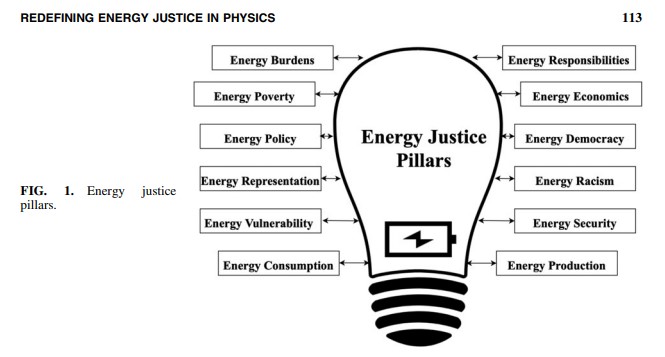
K-12 classrooms are being used by corporations to advance political ideologies such as critical race theory, queer theory, and environmental racism. These destructive ideas are foundational to new policies being implemented in schools. Examples include students being segregated by race, gender transitions without parental consent, and using discussions on the environment to shame white students.
In 2021, Parents Defending Education released the Consultant Report Card, highlighting how much money education consultants were being paid to introduce controversial ideologies such as critical race theory into schools. Our Cracked Foundations report exposed how philanthropic foundations are using large grants to advance woke ideology through K-12 classrooms. In the same vein, corporations are seizing the opportunity to use environmental, social, and governance (ESG) standards to further the encroachment of critical race theory, queer theory, and climate activism into school systems.
As companies adopt ESG standards, the discussion about how to integrate education into an organization’s ESG focus has become increasingly robust. Businesses are seeking ways to boost their own ESG corporate rating, which benefits from investment in K-12 education. Companies also view involvement in education as a long-term net benefit by ensuring that future employees are ESG- and UN Sustainable Development Goals-oriented. They also see it as an opportunity to generate revenue.
ESG is a set of operating principles that prioritizes a stakeholder-centric, public-private partnership, approach to solving alleged systemic inequities and the “climate crisis.” It determines the value structure around an organization’s or school district’s commitment to advancing “sustainability” and social justice issues in place of a traditional academics focus.
Additionally, investment firms are advocating that school districts adopt ESG standards and policies to boost interest from investors when it comes to bond initiatives. Municipal bonds are considered “low risk investments,” and are a tax-free way for a district to “spread debt repayment over an extended period.” The more ESG-compliant the policies, lessons, and activities a school district implements, the better it looks to banks and firms that service municipal bonds.

Key Takeaways:
- Environmental: focuses on advancing ideas such as environmental racism, net zero and climate crisis policies
- Social: focuses on advancing ideas such as critical race theory, queer theory, and equity policies
- Governance: focuses on the policies put in place to realize and advance the environmental and social factors
WHAT IS ESG?
ESG stands for Environmental, Social, Governance – and each of the three focuses breaks down issues by category, such as how a school district is teaching and tackling climate change (environmental), a district’s diversity, equity, and inclusion efforts (social), and hiring practices and bid allocations toward “marginalized groups” (governance).
Environmental factors indicate how an entity operates in relation to topics such as climate, energy consumption, pollution, and other environmental risks. Social incorporates values and relationships of those people involved in the organization. Factors of social include racial justice, diversity and inclusion efforts, and the application of equity policies.
According to the World Economic Forum, governance includes factors such as “corporate structure, board composition, business ethics and anti-corruption.” The WEF also adds that besides governance being “one-third of the ESG equation, the G is also foundational to the realization of both the E and S.
ENVIRONMENTAL, SOCIAL, AND GOVERNANCE IN K-12 SCHOOLS
ENVIRONMENTAL
The “Environmental” component of ESG directs how a school district puts into action governance policies centered around focuses such as environmental racism and the “climate crisis.” This includes lessons and discussions focused on privilege, student climate activism, and professional development.
In November 2022, an external review performed for Weston Public Schools’ social studies and history education program highlighted a fifth-grade class discussion that focused on “environmental racism.” The document states that the observers noticed “considerable comfort and sophistication among (white) students discussing racism and how environmental policies often advantage white communities.” Review of the district’s social studies and science curriculums reveal “environmental racism” is absent in the documents. However, a self-study done by the district in 2021 shows that Weston Public School teachers “made a commitment to active antiracism” including professional development on the topic.

Another aspect of the environmental component is student activism. Jackson-Reed High School (formerly Woodrow Wilson) in Washington, D.C., offers its students the opportunity to be part of the Sunrise Movement Club. According to its webpage, the Sunrise Movement is a “national, youth-led climate movement dedicated to promoting Green New Deal legislation and other climate reforms.” It goes on to state that the club “raise awareness about the Green New Deal” and “discuss the relationship between capitalism and climate change.” Club activities include “participating in climate protests,” “weekly discussions on anticapitalist climate advocacy,” and “working to support the Sunrise Movement.”
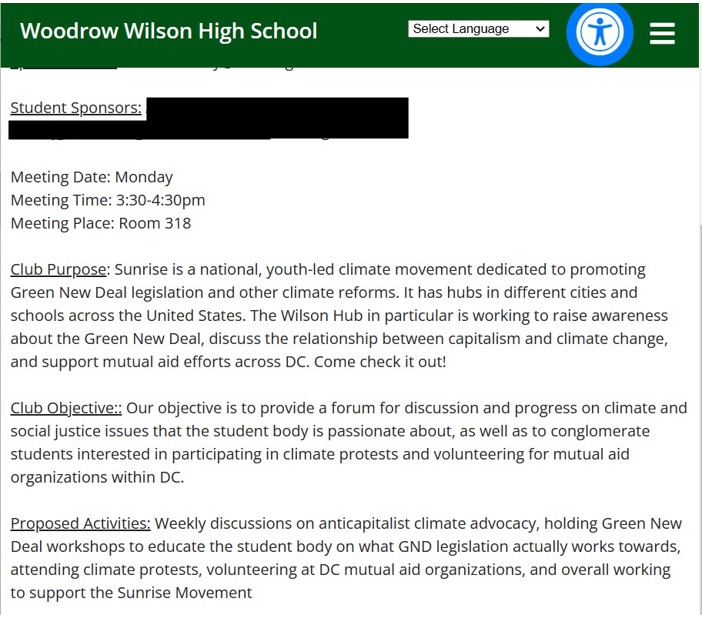
Below are additional examples of how Environmental policies are integrated into K-12 schools.
- Educational Service District 112 (WA): Climate Justice League Inspires Action
- Journal of Science Teacher Education: Exposing and dismantling systemic racism in science education
- Los Angeles Unified School District (CA): School Board Approves Transforming Teaching of Climate Change
- National Education Association: Climate Change Education in Every Subject
- Northshore School District (WA): Rantz: Teacher uses science class to label white middle schoolers privileged oppressors
- Portland Public Schools (OR): Portland Public Schools science courses in high school focus on ‘climate justice’ and ‘social justice’
- San Francisco Unified School District (CA): SFUSD Teaches Environmental Literacy and Climate Justice to All K-12 Students
- San Mateo County Office of Education (CA): San Mateo County Office of Education provides ‘Environmental and Climate Justice’ resources
SOCIAL
The “Social” component of ESG focuses on a school district’s values and relationships in accordance with the policies laid out through governance. This includes diversity, equity, and inclusion efforts; social justice activism; culturally responsive teaching; social and emotional learning; racial affinity groups; access to health clinics; data privacy and technology; and equitable practices.
One aspect of the social component in ESG is a district’s advancement of racial and social equity through activities and curriculum. For example, districts have enacted resolutions or policies (governance) recognizing Black Lives Matter at School Week of Action. The BLM-focused lessons are incorporated into K-12 schools as part of its Black History Month programming. The weeklong curriculum is based on the Black Lives Matter 13 principles, which include “disrupting the Western prescribed nuclear family” and freeing society of “heteronormativity” and “ageism.”
A school district’s commitment to “wellness,” as defined by the World Economic Forum and UN, affects its overall rating. For example, Denver Public Schools, through a grant from the Wallace Foundation, advances the ESG agenda through its Transformative Social Emotional Learning (TSEL) programming. The SEL variant is intended to use the classroom to redistribute “power to promote social justice.” The TSEL framework seeds a racial justice and equity lens into the minds of young learners through lessons and curriculum. One of its top proponents, Dena Simmons, states in a tweet that “without racial context, SEL is white supremacy with a hug.”

Additionally, school districts are utilizing educational technologies to monitor for online harassment and bullying, and to track student use of social media under the guise of SEL. For example, Cherokee County School District in Georgia contracted with Social Sentinel (now part of Navigate360) in 2019 to “provide alerts on public social media and e-mail platforms.” The district sought out the services to “augment” its “Social Emotional Learning (SEL) and Safety/Security” including “public safety, security and wellness.”
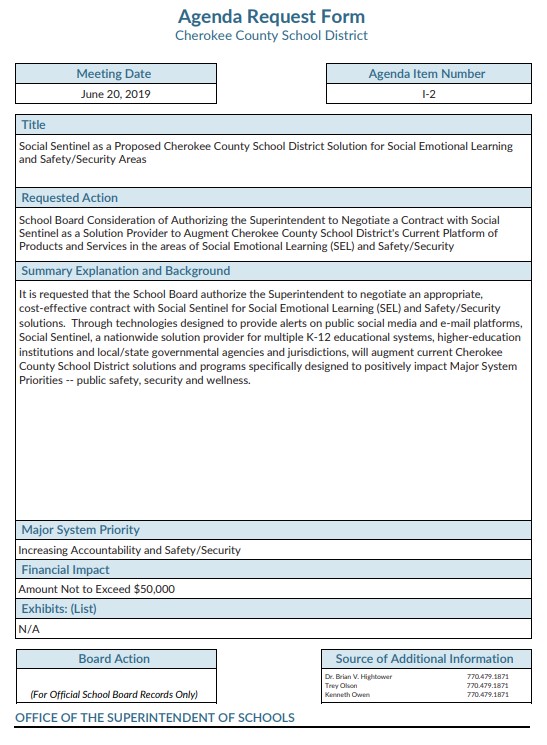
Below are additional examples of how Social policies are integrated into K-12 schools.
- Boston Public Schools (MA): Boston Public Schools’ ethnic studies curriculum focuses on oppression and ‘Pillars of White Supremacy’
- Chicago Public Schools (IL): Chicago Public School student protest in-person learning with district-wide walkout
- Lower Merion School District (PA): Lower Merion School District uses race-based affinity groups for students as young as fourth grade, claims 7 month olds can ‘discern race and show preferences.’
- NASA: GBH “Framework For Diversity and Equity in K-12 Science Educational Media”
- Norwalk-La Miranda Unified School District (CA): California School Board May Open Planned Parenthood Clinic at LA High School
- Parkway Schools (MO): Transgender Center Staffers at Washington University of St. Louis and St. Louis Children’s Hospital Advise Parkway Schools Not to Tell Parents About Child Chest Binder Use
- Phillips Exeter Academy (NH): Phillips Exeter Academy courses include ‘Mathematics of Social Justice’ and ‘Science Health and Race in America’
- Topeka Public Schools (KS): Middle school staff coordinates with GSA club to facilitate student walkout; district policy is to hide students’ gender transition from parents
GOVERNANCE
The “Governance” component is implemented through the school district’s purpose, the demographic makeup of the personnel (such as gender and racial diversity), how staff are contracted and paid, and how policies affect all stakeholders. It prioritizes the impact decisions have on all stakeholders, not just the parties involved. It is through governance that ESG complaint policies are created at the administrative level, and then put into action in the social and environmental factors.
In 2021, the Salt Lake City School District produced its “2040 Sustainability Action Plan” that set goals to go full green energy by 2030, as well as to eliminate all fossil fuel use by 2040. The plan claims that when pursuing sustainability, those with “more resources” benefit the most. Therefore, it aims to combat “inequities” by centering “underserved communities” in all decisions. The district provides an “equity worksheet”to aid in the process. “The Equity Worksheet is a list of questions designed to help Salt Lake City School District (SLCSD) implement the Sustainability Action Plan in a way that addresses systemic inequities.”
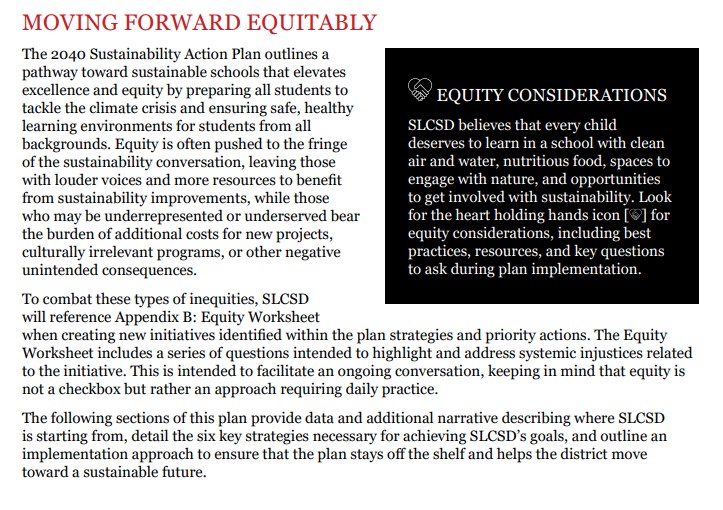
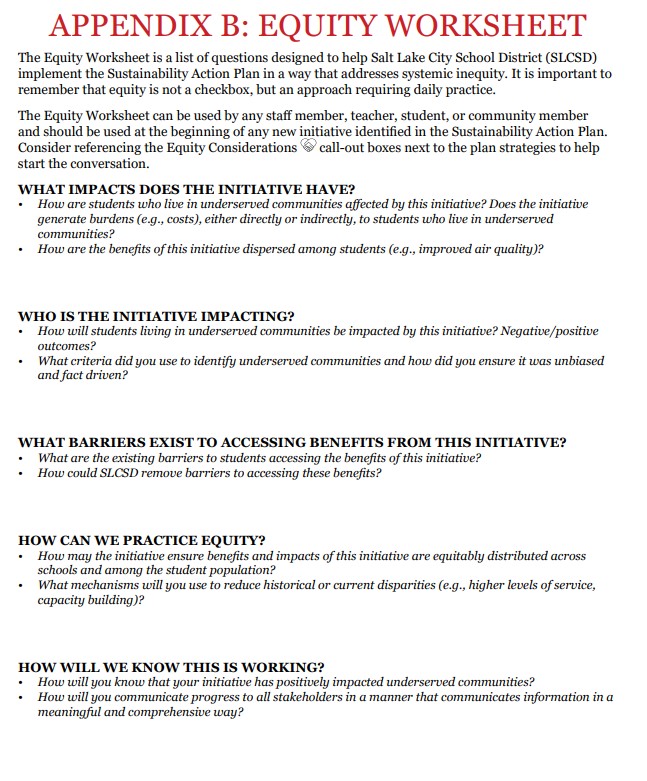
For example, the Dallas Independent School District bidding process for outside contractors and consultants includes a 20-point category (out of a total 100 points) that prioritizes a “marginalized” or minority status of the bidding company’s leaders or ownership. In other words, the district uses the skin color and gender of the applicants as part of the overall scoring method when determining the worthiness of a contract.
In Maine, the Kennebec Intra-District Schools policy for “Students Who Are Transgender and Gender Expansive” gives authority to the school district and staff to withhold notification to parents should a student reveal they are transgender. The policy declares that a student’s ”health and safety” is its top consideration. The document states that the “principal and/or school counselor will continue to work through family issues with the student with a goal of acceptance by all.”
Districts also utilize student and staff surveys to craft and enact new policies. The Austin Independent School District used a 2017 student survey as the driver to craft its district wide LGBT policies and curriculum. The survey for students able to “select ‘boy,’ ’girl,’ or ‘I’d prefer to self-identify.’” Pulling out the data from students who chose to “self-identify,” the district concluded that those students had a higher amount of mental health issues compared to their peers. The solution was to develop a more “inclusive” school environment and curriculum that would prioritize the specific sub-group of students.
Below are additional examples of how Governance policies are being integrated into K-12 schools.
- Albermarle County Public Schools (VA): Albemarle County Public Schools assistant superintendent appears to tell staff to quit if they disagree with district’s “Anti-Racism Policy”; middle school principal hosts training session for faculty with presenter encouraging adults to allow toddlers to “explore” their gender identity
- Eau Claire (WI): Eau Claire Area School District provides school staff with “Administrative Guidance” to support transgender students; appears to support students using “medical” and “surgical” procedures to transition to another gender
- Fairfax County Public Schools (VA): Fairfax County Public Schools seeks to pay up to $200,000 for ‘social media management’ and surveillance
- Jefferson County Public Schools (KY): Racial Educational Equity Plan
- Knox County Schools (TN): Vice Chair of Knox County Schools Board is member of consultant group hired to do equity audit; consultant advocates for teacher affinity groups
- Okemos Public Schools (MI): Okemos Schools’ DEI director warns that teachers who don’t use students’ preferred pronouns’—even behind parents’ backs—”could potentially fall under our harassment policy”
- Prince Georges County Public Schools (VA): Climate Change Action Plan
- Portland Public Schools (OR): Portland Public Schools ‘Climate Crisis Response’ policy centers ‘racial equity’ and ‘climate justice’
Stay Informed

